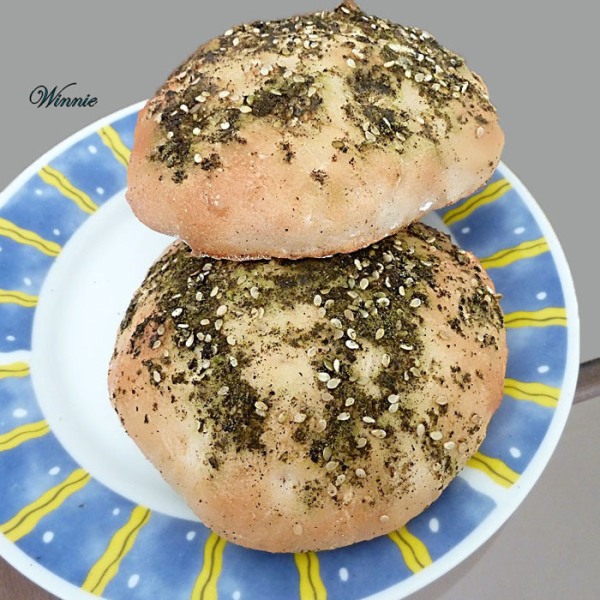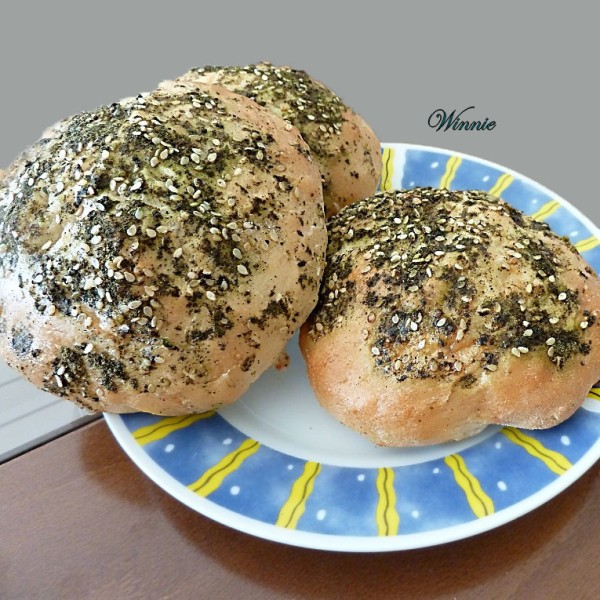Pita-bread with Zaatar (middle-east spice), sesame and olive oil

Very easy to make, and very tasty. We actually love to eat it with Tehina or Hummus (spead made of chickpeas), but it's great with everything

For recipe and more photos, pease visit my post
My blog and my posts are in Hebrew, but translator is available (top left side-bar)
- Winnish's Blog
- Log in or register to post comments
Absolutely wonderful! I swear, I am salivating here...
Thank you SallyBB!!
These look great! The last time I made pita it came out as dinner rolls. I'll see if I can figure out your approach with the help of the translator. I have a big bag of zaatar just waiting to be used. -Varda
Hi Varda
Thanks!!
If you want the pita-bread to be thinner and with a "pocket" (and less as rolls), want you need to do is flatten the balls before baking and bake at 570 F (4-5 minutes)
You can see it here
If you have problems with the translation, don't hesistate to ask me
They look great, Winnie. Did you glaze them with and egg wash before you applied the Zatar? Nice baking.
Syd
Hi Syd - Thanks!!!
Yes, I did. I spread some olive oil, then brush with egg wash (1 whole egg+2 tsp of olive oil) and on top scattered lots of sesame-zaatar
Thamk you cfmuirhead :)
You can translate my post to almost every language you want. There are 2 translators at the top left side-bar.
The translation can get funny sometimes (hilarious is a better work for it), so if you have any question - don't hesitate to ask me.
Beautiful pita, Winnish! Got to make this soon. Thank you for sharing.
Can I please ask you a few quetions?
I couldn't quite understand some of the translation....
Does this mean, 'if you want to make pita bigger, you flat the dough out more'?
Also....
Am I right in thinking this is the same method as you'd do when making focaccia, poking the dough to make dimples?
Kind regards,
lumos
Thank you lumos! I appreciate you comment!
Of-course you can aske me regarding the translation. As I wrote before it can get real-funny.
A) If you want the pita-bread to be more flattened, you should simply flattend the balls a bit more.
I wrote it because regular pita-bread is usually like this as you can HERE.
B) Yes. exactly - poking the dough to make dimples
Speaking of funny translation!! Wowoooooo - I couldn't understand why "my liar friend".
Now I got it. I actually wrote - "as my dear friend Keren did" , and due to Hebrew grammer (relative etc) - "as Keren" is one word that spells exactly as "liar"
Errrrrrrrrrrrrrg. hahahaha. I have to tell her - she's gonna laugh
You were right the Google translation worked well enough for me to get the gist of the recipe. What flour do you use? All purpose or Strong Bread Flour? I saw recipes with pitta that use both. Have you tried including part of the flour as whole wheat to nutritional reasons? I shall try your recipe very soon, the pictures were so enticing! Thank you.
Thanks, Winnish. Pita I've been making is usually like the ones on the link above, so I am really intrigued to find out your more round version would be like. Thank you for showing me another possibility of making pita.
Yes, automatic translation can give you a good laugh sometimes. In Japan where I originally come from, some one even published a series of books (all famous Japanese fairy tales) which was translated into English by a machine translator and translated back to Japanese, again, by a machine translator. It was so hilarious it stayed as the bestseller for many months!
Best regards to your dear honest friend, Karen! :p
lumos
Lumos, This pitta recipe seems great and It seems that you are going through a lot of trouble translating the recipe? In what language are you translating? If in english french or italian, would be mind very much sending me your translation even if a little cryptic and not perfect. As long as I can understand, I can cope. Thank you so much.
Hi cfmuirhead
If you can wait till Sun, then I can send you the translation.
Fri is short day for us, and Fri evening till Sat's night I can't use the computer (as we are religious).
Have a great weekend
Winnie
cfmuirhead - I have just send you the translation by message
Hope it help you :)
Winnie
Thanks lumos
I loved your last line - I will definitely tell Keren :):)
Hi lumos
I've just told Keren (and also gave her your regards) and we had a good laugh about it/
BTW - very good idea the series of books!!
No, I didn't translated it myself, 'shalom' being the only Hebrew I know other than some names of Jewish foods. Hebrew sentence in my post was just copied&pasted from his page. I don't even know how to read it! :p
I only clicked the Union Jack for automatic translation into English on his site (Just below the top banner, on the left side part of the page. You see a group of several flags? ) . It's not a perfect translation, as none of machine translation is, but you can more or less understand. ;)
But if you're having a trouble in using that automatic tranlator on the site, I can copy&paste the English translation text and send it to you, if you'd like. Let me know. :)
Thanks - that is very kind. I have used the automatic translator and to my great surprise, it worked quite well - enough to understand the recipe. The only thinkg I wanted to kno and did ask Winnie is which flour she used: All purpose or Strong bread flour. i have seen recipes made with either but would have liked to know what she used. Which did/will you use? I made pita last week using strong bread flour: half half white and whole wheat and they turned out pretty good.
Glad you found the automatic translator not totally useless.;p
I have several recipes for pita myself, most of them based on the recipes by Greek or Lebanese or Turkish food writers. From what I've gathered, it seems the flour they use to make pita or flatbread is a sort of between our (I see you're in UK, too) strong flour and plain flour. So I usualy mix them 50:50, adjusting the ratio depends on what sort of pita/flatbread I'm making; if I want it's thicker version with slightly softer,fluffier texture than ordinary pita (the sort you buy from shop) I increase the amount of strong flour and if it's thinner, flatter version (like lavash), I mix more plain flour in.
But Winnish's recipe might be Jewish version which I'm not very familiar with, so I'd be very interested to hear what he?she? uses, too. :)
Hi
I appologize for my short answer (I have 5 minutes before I must turn off the computer) - but I just want to say that in pita-bread I use plain white flour.
I usually use bread-flour (for all my challahs, and yeast-pastries) but for pita-bread I use plain white flour
Thanks, Winnish.
Can I please ask you what the protein level of your plain flour is where you are?
btw, I'd be very interested to see Challah you make. It must be properly authentic.
Hi lumos
The protein level of the plain flour here (Israel) is about 10%
Baking challahs is my specialty. It's a passion and I lovvvvvvvvvvvvvvve it.
You are more than wellcome (!!) to check them out.
My blog is quite new, and I already have a few challah-recipes, and they are all my own.
They are all under "Apply" lable (left side-bar),
and that it because the word "challahs" (plural) in hebrew can also be read as "apply"
Winnie
Thanks, Winnish!
ooooooh, authentic challah recipes from Israel! I'll sure to look into them.....under 'Apply' :D
But to be honest with you, I'd rather eat the ones you made!
Best wishes,
lumos
Thank you!:)
I realy appreciate it!